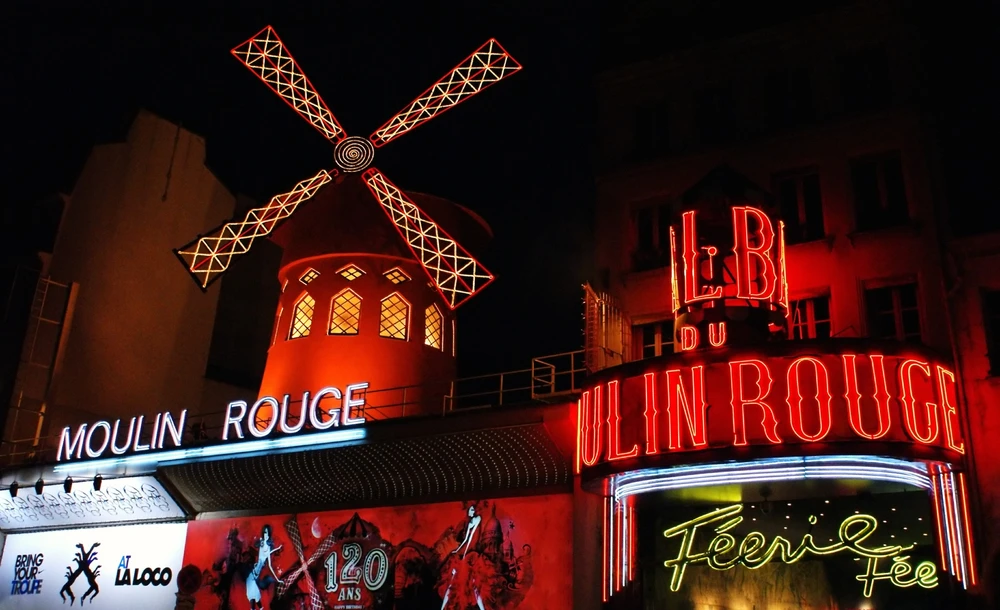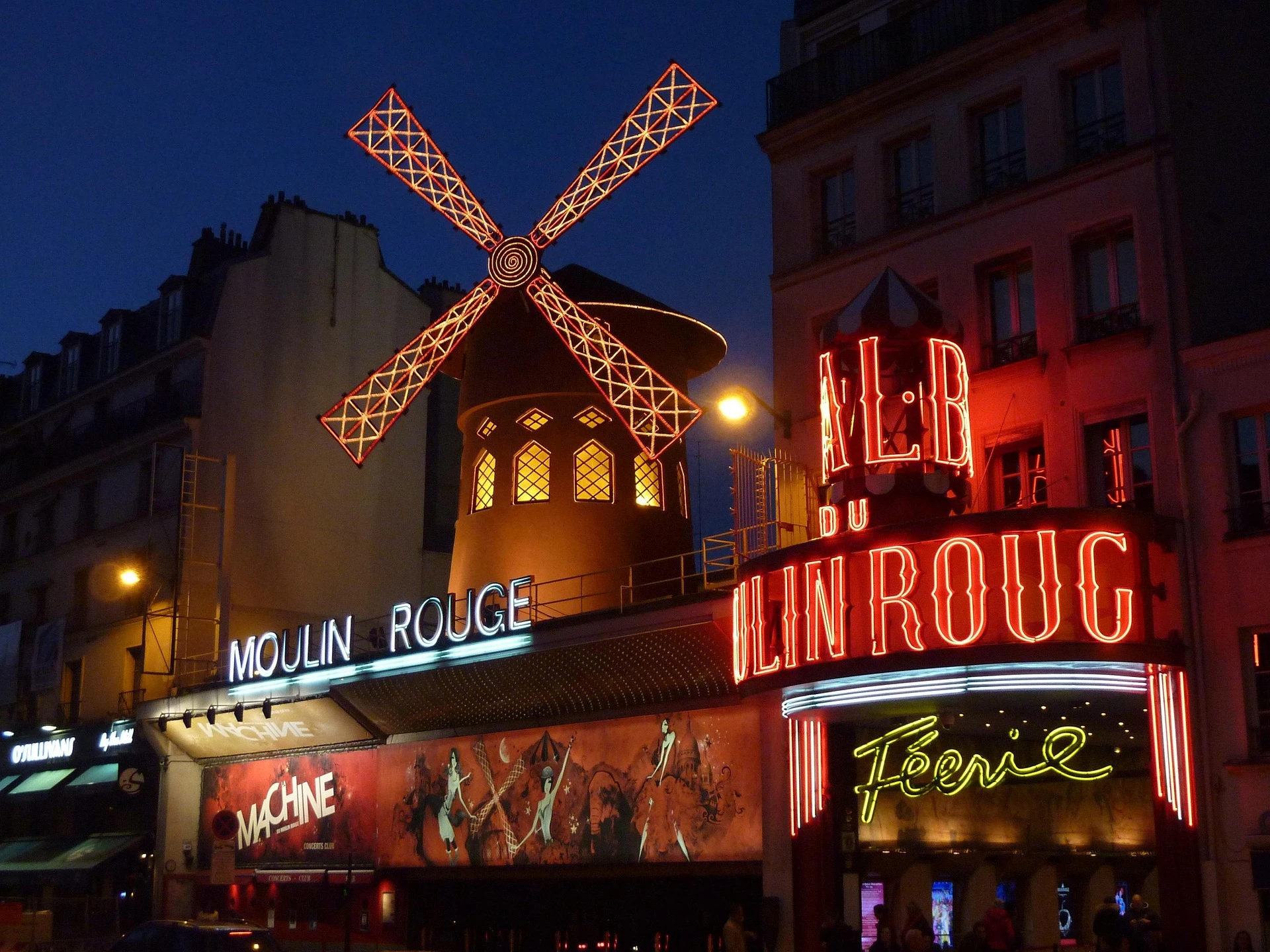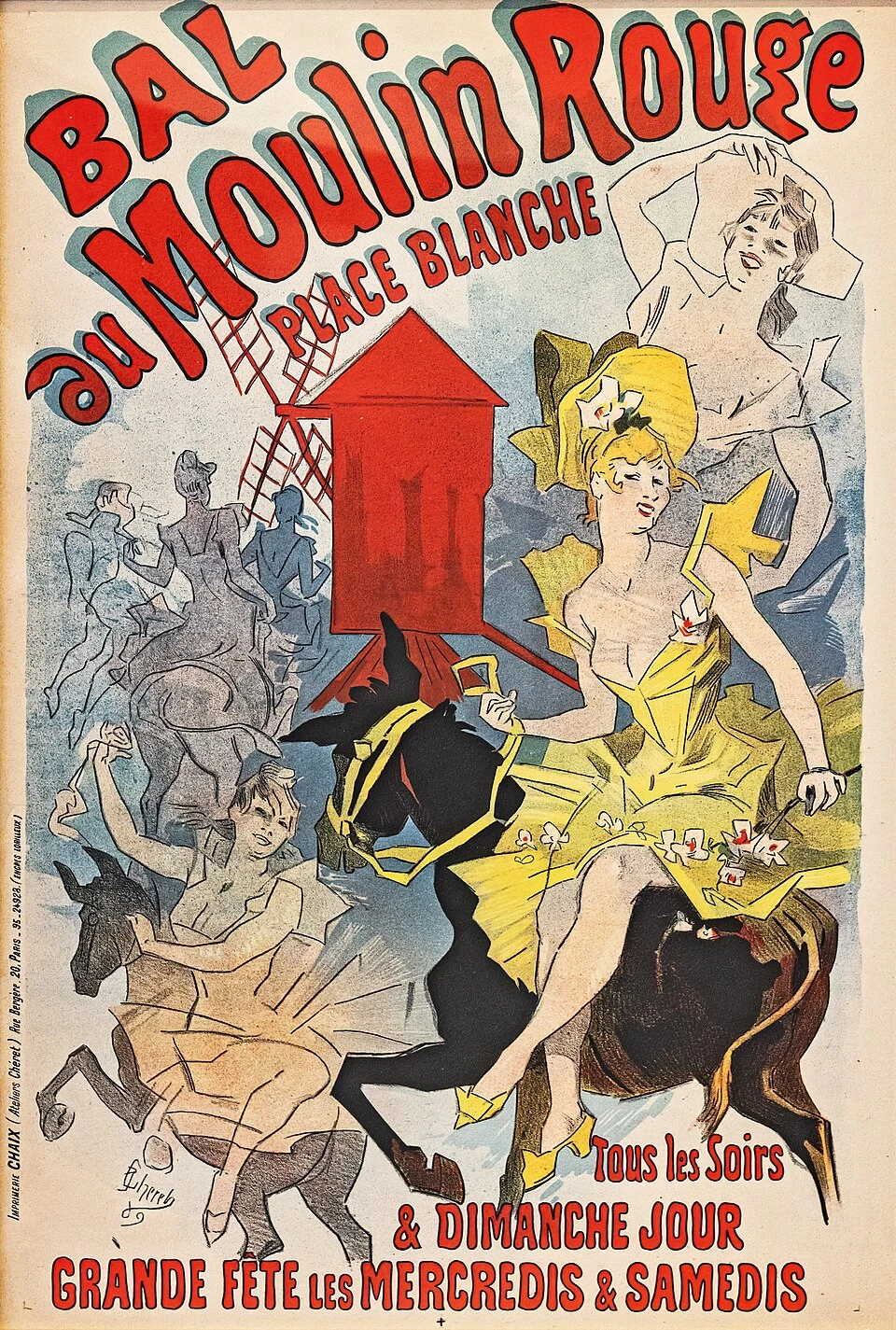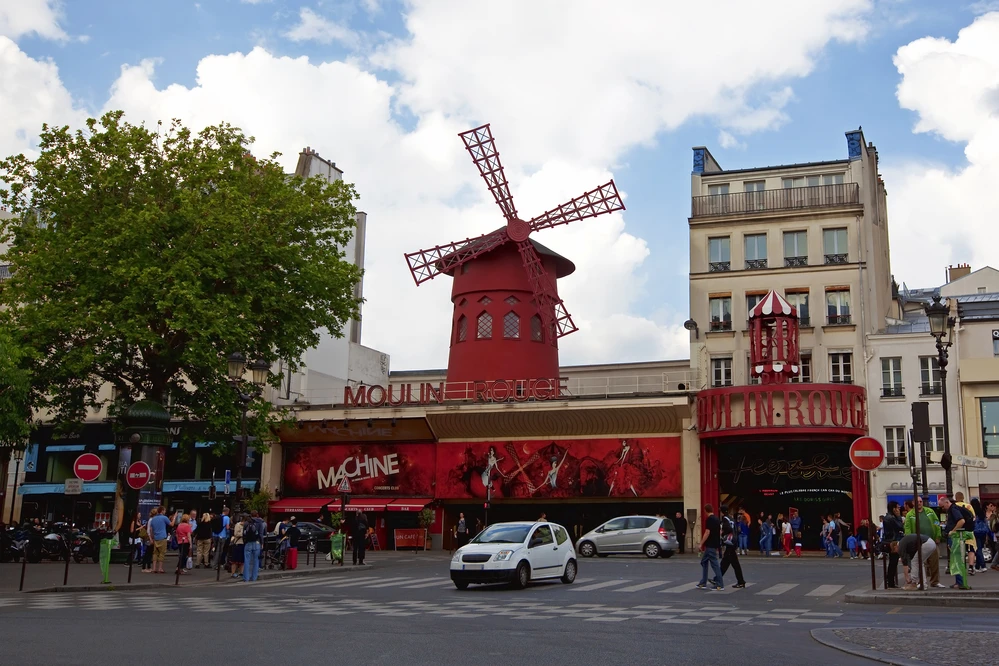Here is what you will discover in this article:
You’ll learn the real history of the Moulin Rouge and how it became a Parisian icon.
You’ll get practical information on schedules, pricing, seating and dress code.
You’ll discover behind the scenes and the rare crafts that create the costumes.
Finally, you’ll find tips to make the most of your evening at the cabaret.
The Moulin Rouge: an iconic venue in Montmartre
The Moulin Rouge at night. Photo selected by monsieurdefrance.Com: depositphotos.
It is located in the 18th arrondissement, at the foot of Montmartre hill (Place du Tertre is a 15-minute walk away), not far from Place Pigalle (named after the sculptor Pigalle). It is the most famous cabaret in Paris and one of the very last to continue the glitter and glamour shows that made Paris famous. It offers a colorful four-act show, the highlight of which is the famous French Cancan, which was born here from the imagination of the scandalous dancers of the time. In total, more than 80 artists perform on stage, including international artists such as acrobats and jugglers. "Féérie" is the name of the show at the Moulin Rouge. It has already won over 12,000,000 people since its creation on December 23, 1999. The shows have often changed at the Moulin. In 1889, circus arts were more popular, and the most famous act was that of... Petoman.
Moulin Rouge opening hours, packages, and prices
You can experience the Moulin Rouge in two ways: dinner and show (at 7:00 p.m.) or show only (at 9:00 p.m. and 11:00 p.m.).
In 2025, the dinner show including a menu (vegan option available) and half a bottle of champagne per person starts at €225. The show alone starts at €110, with champagne as an option. Prices vary depending on the date and time: 9:00 p.m. or 11:00 p.m., but sometimes prices are slightly lower (€90) depending on the date and time. There is also a VIP package (€445). The Moulin Rouge has the largest culinary team in France. Men are not necessarily required to wear a suit and tie, but it is recommended that you dress up (after all, it is a prestigious venue and you are going out). Bermuda shorts are not allowed. Caps and hats are also not allowed. Please note that luggage is not allowed.
To reserve your date and find out the current rates, click here.
The unique professions of the Moulin Rouge: behind the scenes and expertise
photo selected by monsieurdefrance.com: Tum Tin99 via depositphotos
The Moulin Rouge has 450 employees , including 60 dancers (the Doryss girls), 20 dancers (the Dorys boys), as well as a chef, cooks, head waiters, waiters, etc. Some have rare professions such as feather workers (for the dancers' costumes) or embroiderers (who specialize in the difficult art of rhinestone embroidery). The company also works with dedicated bootmakers who specialize in the manufacture and maintenance of dance shoes. This company, Maison Clairvoy (rue Fontaine in Paris), is one of the few, if not the only one, that knows how to make the special boots worn by French cancan dancers.
What people often don't know about the Moulin Rouge
The Moulin Rouge is also a nightclub and concert hall with "la machine du moulin rouge" located at 90 Boulevard de Clichy and spread over four floors.
Impressive figures: the Moulin Rouge in data
The Moulin Rouge is: 500 people served every evening by France's largest culinary team (120 people). It is the world's largest private consumer of champagne, with 240,000 bottles per year (in 700 silver champagne buckets) for 600,000 spectators.
Practical tips for getting the most out of the Moulin Rouge
The Moulin Rouge / Photo by Hermann Traub from Pixabay
For the best view of the stage, the best seats are those located in the center and slightly elevated, which offer a perfect view of the French Cancan and the tableaux. It is advisable to arrive 30 to 40 minutes before the start of the show to avoid waiting and to calmly enjoy settling into your seat. The show lasts approximately 1 hour 45 minutes to 2 hours, without an intermission. Regarding photos: they are not allowed during the show, but are possible before and after.
Children aged around 6–7 and above are welcome, but the show is still a cabaret with artistic nudity. Yes, it's noisy, which is part of the festive atmosphere. Yes, the venue is air-conditioned—which is appreciated when you're surrounded by 500 spectators.
Is it worth it? Definitely yes, if you love dance, live performances, rhythm, and the history of Paris. Which ticket should you choose? If it's your first time, the dinner and show package is a wonderful way to immerse yourself in the experience; if you're mainly interested in the show, the show-only package is sufficient. The atmosphere in the theater is joyful, cosmopolitan, and international, with an enthralled audience that lets itself be carried away. The show is aimed primarily at curious adults, performance enthusiasts, lovers of Paris, and anyone who wants to experience a unique moment.
A brief history of the Moulin Rouge (with its secrets and anecdotes)
Bal au Moulin Rouge, poster by Jules Chéret, 1889. By Didier Descouens — Own work, Public domain, https://commons.wikimedia.org/w/index.php?curid=110083542
The Moulin Rouge was founded in 1889, at the same time that Paris inaugurated the Eiffel Tower. At the time, Montmartre was a bohemian neighborhood, filled with artists, merry drunks, famous painters, and loose women. The cabaret quickly became a place of wild partying, where people danced, drank, laughed, and dared. It was here that the French Cancan was born, initially as a provocative dance—at a time when showing your ankles was already daring.
The iconic Moulin Rouge poster was designed by Henri de Toulouse-Lautrec, a major figure at the venue. He immortalized dancers such as La Goulue, a charismatic star and heavy champagne drinker, and Jane Avril, who had an electric, almost nervous, fascinating way of dancing. It is said that La Goulue, in the middle of a show, would recognize spectators and shout: "Hey you! I saw you last night at the ball!" This would trigger bursts of laughter.
La Goulue and Valentin le Désossé dancing at the Moulin Rouge, 1895, Théophile Alexandre Steinlen / By Didier Descouens — Own work, Public domain, https://commons.wikimedia.org/w/index.php?curid=110082860
In the 1920s, the Moulin Rouge was a temple of elegance, frequented by princes, maharajas, and even... Charlie Chaplin. After a fire in 1915, it was reborn, and in 1999 the current show, "Féérie," was created, seen by more than 12 million people. Thus, for more than 130 years, the Moulin Rouge has continued to embody Parisian audacity, celebration, and magic.
How to get to the Moulin Rouge: access and transportation
The Moulin Rouge by day: photo selected by monsieurdefrance.com: YAY-images via deposithotels.com
Address:
82 Boulevard de Clichy, 75018 Paris
Metro:
WHITE station, line 2
Station PLACE CLICHY lines 2 and 13.
There will be
Lines 30 and 74 (the closest), but also 68 and 80.
Parking:
INDIGO PIGALLE THEATRES parking lot (674 meters away) 10/12 rue Jean Baptiste PIGALLE 75 009 PARIS
Official website:
The official website of the Moulin Rouge.
The Moulin Rouge at night in 1910 / Postcard Source: Wikimedia Commons
FAQ about the Moulin Rouge
What is the dress code at the Moulin Rouge?
Smart attire is recommended. Bermuda shorts, baseball caps, and other headwear are not permitted.
Can we attend the show without dinner?
Yes, there are show-only seats available at 9:00 p.m. and 11:00 p.m.
Did the French Cancan originate at the Moulin Rouge?
Yes, it was invented here by the dancers of the time.
Is it necessary to book well in advance?
It is strongly recommended to book, especially on weekends and during the summer.
Is the show suitable for children?
It remains an adult cabaret: the show contains artistic nudity.
Can we visit during the day?
No, the Moulin Rouge is not open to tourists: it only operates as a theater or dinner theater.










